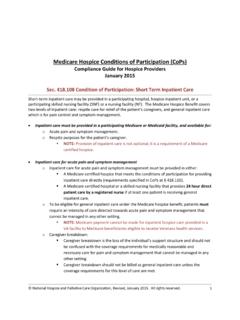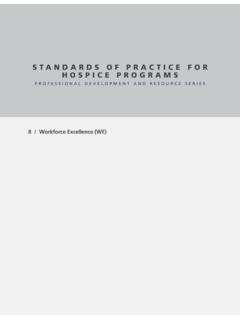Transcription of NHPCO Facts and Figures
1 NHPCO Facts and Figures 2020 edition . Published August 20, 2020. Section 2: Who Receives Section 4: How Does Medicare Hospice Care Pay for Hospice z H. ow many Medicare beneficiaries z Spending per Patient received care? z Spending by Days of Care z W. hat proportion of Medicare z Spending by Diagnosis decedents were served by hospice? z Spending by Level of Care z W. hat % of hospice patients were enrolled in Medicare Advantage? z W. hat are the characteristics of Section 5: Who Provides Care Medicare beneficiaries who received z H. ow many hospices were in Table of Contents hospice care?
2 Gender z operation in 2018. Provider Size Please see the Data Sources Section Age z Tax Status at the end of this report for details Race z Patient Volume on the data sources used within this Principal Diagnosis z Admissions publication. z Deaths Section 1: Introduction Section 3: How Much Care z About this report was Received Reference: Data Sources z What is hospice care? z Length of Service and Methodology z How is hospice care delivered? z Days of Care z What services are provided? z Deaths z Location of Care z Discharges z Levels of Care z Level of Care z Volunteer Services z Location of Care z Bereavement Services Facts and Figures | 2020 edition rganization 1.
3 Introduction What is hospice care? Considered the model for quality compassionate care for people facing a life-limiting illness, hospice provides expert medical care, pain management, About this Report and emotional and spiritual support expressly tailored to the patient's NHPCO Facts and Figures : Hospice Care in America provides an needs and wishes. Support is provided to the patient's family as well. annual overview of hospice care delivery. This overview provides specific information on: Hospice focuses on caring, not curing. In most cases, care is provided in the patient's home but may also be provided in freestanding hospice z Hospice patient characteristics facilities, hospitals, and nursing homes and other long-term care facilities.
4 Z Location and level of care Hospice services are available to patients with any terminal illness or of z Medicare hospice spending any age, religion, or race. z Hospice provider characteristics z Volunteer and bereavement services Consideration for discussion around differences in numbers reported by other authorities like MedPAC: This report presents metrics that may Currently, most hospice patients have their costs covered by Medicare, differ from other reporting sources eventhough the data sources are through the Medicare Hospice Benefit. The findings in this report reflect from CMS.
5 This is a result in differing approaches and/or rules being only those patients who received care through 2018, provided by the applied such as use of fiscal vs calendar years, ICD Codes, and other Medicare Hospice Benefit by the hospices certified by the Centers for historical lookback models. Please be aware of this when using the data Medicare and Medicaid Services (CMS) to care for them. for analysis and comparison between analytic vendors. Facts and Figures | 2020 edition rganization 2. Introduction (continued). How is hospice care delivered? Typically, a family member serves as the primary caregiver and, when appropriate, helps make decisions for the terminally ill individual.
6 Members of the hospice staff make regular visits to assess the patient and provide additional care or other services. Hospice staff is on-call 24 hours a day, seven days a week. The hospice team develops a care plan that meets each patient's individual needs for pain management and symptom control. This interdisciplinary team, as illustrated in Figure 1, usually consists of the patient's personal physician, hospice physician or medical director, nurses, hospice aides, social workers, bereavement counselors, clergy or other spiritual counselors, trained volunteers, and speech, physical, and occupational therapists, if needed.
7 &. What services are provided? The interdisciplinary hospice team: z Manages the patient's pain and other symptoms;. z Assists the patient and family members with the emotional, psychosocial, and spiritual aspects of dying;. z Provides medications and medical equipment;. z Instructs the family on how to care for the patient;. z Provides grief support and counseling;. z Makes short-term inpatient care available when pain or symptoms become too difficult to manage at home, or the caregiver needs respite time;. z Delivers special services like speech and physical therapy when needed.
8 Z Provides grief support and counseling to surviving family and friends. Location of Care The majority of hospice care is provided in the place the patient calls home. In addition to private residences, this includes nursing homes and residential facilities. Hospice care may also be provided in freestanding hospice facilities and hospitals (see Levels of Care). Facts and Figures | 2020 edition rganization 3. Introduction (continued). Levels of Care Hospice patients may require differing intensities of care during the course of their disease. While hospice patients may be admitted at any level of care, changes in their status may require a change in their level of care.
9 The Medicare Hospice Benefit affords patients four levels of care to meet their clinical needs: Routine Home Care, General Inpatient Care, Continuous Home Care, and Inpatient Respite Care. Payment for each covers all aspects of the patient's care related to the terminal illness, including all services delivered by the interdisciplinary team, medication, medical equipment and supplies. z Routine Hospice Care (RHC) is the most common level of hospice care. With this type of care, an individual has elected to receive hospice care at their residence. z Continuous Home Care (CHC) is care provided for between 8 and 24 hours a day to manage pain and other acute medical symptoms.
10 CHC services must be predominately nursing care, supplemented with caregiver and hospice aide services and are intended to maintain the terminally ill patient at home during a pain or symptom crisis. z Inpatient Respite Care (IRC) is available to provide temporary relief to the patient's primary caregiver. Respite care can be provided in a hospital, hospice facility, or a long-term care facility that has sufficient 24 hour nursing personnel present. z General Inpatient Care (GIP) is provided for pain control or other acute symptom management that cannot feasibly be provided in any other setting.












